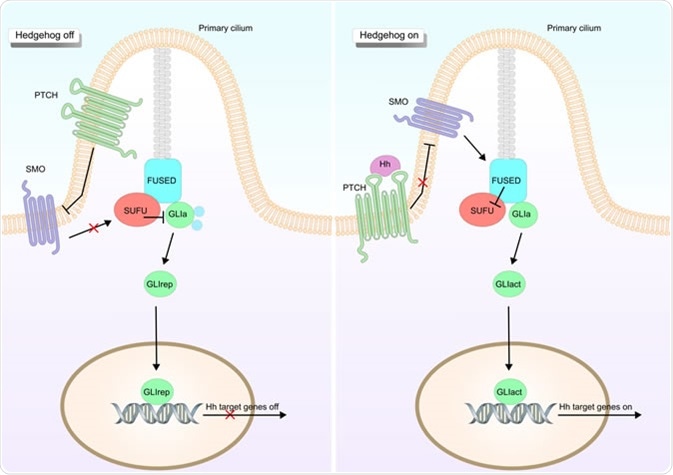Generally, the limb buds of an embryo develop at the first trimester of pregnancy, which is followed by the growth of fingers and toes. Limb patterning usually refers to the shaping of hands and feet, which directly involve the fingers and toes respectively.
Studies have revealed some key genes, among which the Hox genes are responsible for regulating both limbs development and their patterning.
Homeotic Genes
These genes command the shape of the body formation of an organism during embryonic development. It is present in both vertebrates and invertebrates. Homeotic genes present in vertebrates are called Hox genes. 39 Hox genes are present in humans and they are divided into four distinct groups of Hox-A, Hox-B, Hox-C and Hox-D, each located on different chromosomes. The functions of the Hox gene are as follows:
- It provides “Hox” codes which comprise of transcriptional factors that achieve the motif of structures along the longitudinal axis of limbs.
- It regulates the “Sonic hedgehog” (Shh) gene which controls the patterning of distal structures.
- Hox genes play a vital role in the formation of digits (number of fingers and toes).
Regulation of Hox genes
Among the four distinct clusters of Hox genes, A and D are the vital positional regulators of appendages (fingers and toes). Hox-D clusters have been perfectly defined compared to Hox-A group of genes.
In the early stage of embryonic development of vertebrates, Hox genes follow a phenomenon called temporal colinearity, in which genes at one end of chromosome (3’) are expressed more at the head end of an embryo than the genes (5’) toward the tail. This colinearity is not only expressed during anterior to posterior (A-P) patterning of body, but also during the patterning of the proximal to distal (P-D) and A-P axes of limbs and its appendages. Early limb control region (ELCR) and POST (a secondary regulatory sequence) is responsible for the restriction of 5’ genes expression.
In later stages, when the autopods (fingers and toes) are being specified, 5’ genes of Hox-D cluster express inverted spatial colinearity, which displays a well-defined expression pattern of limbs among vertebrates.
Regulatory enhancers of the Hox-D gene: Since the later phase of Hox-D gene expression is associated with autopod formation, it possesses a separate regulatory mechanism. The 5’ location of the Hox-D gene is known as global control region (GCR), which maps the intergenic domain between ATP5G3 and Lunapark (Lnp) genes. CsA and CsB are two preserved regulatory regions that are present within the GCR. Of them the CsB region appears to contain limb-specific regulatory action. CsC is another specific regulatory domain that plays a role in mapping intergenic space between Lnp and Evx2 genes. The expression of non-Hox genes such as Lnp and Evx2 is regulated by both CsB and CsC domains. Hox-D gene expression in limb formation coincides with expression patterns of Lnp and Evx2 genes.
Factors Supporting Limb Patterning
- Sonic hedgehog (Shh): The Shh pathway is vital in the collaboration of early and late phases of Hox-D gene expression. Shh controls the number and identity of digits to be produced. Proper digit patterning requires both the amount and time of exposure toward the Shh protein. Zone of polarizing activity (ZPA), a region located along the posterior side of the limb bud produces Shh protein. The ZPA controls the A-P axis which specifies the position of the thumb versus the little finger.
- Apical ectodermal ridge (AER): AER is the specialized distal ectodermal region of limb buds and it is found to be significant in digit formation. AER signals to underlying mesenchymal layer of cells called progress zone (PZ), which is essential to limb outgrowth. The AER and PZ along with the ZPA protein integrate this process. The “Wnt” family of transcriptional factors is turned on in limb buds, which is specific for arm and leg distinctions. For example, Wnt2b is expressed in forelimb region and Wnt8c is expressed in hind limb region. When the AER begins to fragment, the digits are indented.
- Apoptosis: In order to sculpt the limbs, apoptosis (programmed cell death) is essential. The death of specific cells during autopod development results in non-webbed digits. This cell death is genetically programmed in vertebrate limbs and it is particular during evolution.

Patterning of Limb Appendages
The Hox genes, whose expression pattern seems to be the most relevant for subdividing the limb bud along the A-P axis and hence to potentially specify the unique outcome of each digits are members of Hox-D clusters. 5’ end of that particular cluster genes are Hox-D4, Hox-D5, Hox-D6, Hox-D7, and Hox-D8. The use of these genes, however, would only allow for the specification of five digits. The process of forming separate digit involves Hox gene expression, AER fragmentation, and subsequent apoptosis.
Hox genes distinctly contribute to the regulation of limb patterning, although their exact place in the autopod development is speculative.
Sources
- https://www.sciencedaily.com/releases/2012/12/121214112652.htm
- https://www.ncbi.nlm.nih.gov/pubmed/1363084
- http://emedicine.medscape.com/article/1287982-overview
- http://news.nationalgeographic.com/news/2007/08/070815-shark-gene.html
- http://www.sciencedirect.com/science/article/pii/S0012160607002278
- http://www.cell.com/fulltext/S0092-8674(11)01273-6
- http://dev.biologists.org/content/133/17/3419
- www.nature.com/…/hox-genes-in-development-the-hox-code-41402
Further Reading
- All Genetics Content
- What is Genetics?
- History of Genetics
- Genetics and Gene Expression
- Genetic Change
Last Updated: Jun 25, 2019
Source: Read Full Article
